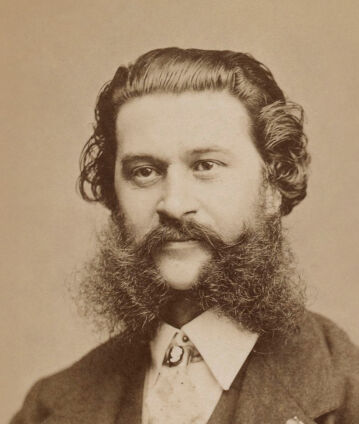ヨハン・シュトラウス2世
作曲
「シュラーガー」という語の最も早い使用例は、1867年の『ヴィーナー・フレムデンブラット』紙に見られる。この語はワルツ《美しく青きドナウ》を評する際に用いられたものである。その作者ヨハン・シュトラウス2世は、当時の「スーパースター」と呼ぶにふさわしい存在であった。彼とその父ヨハン・シュトラウスは、舞踏会場だけでなくコンサートの場でも舞踏音楽を演奏するという革新的な試みを行い、このジャンルをかつてない隆盛へと導いた。「ワルツ王」と称された彼が、ブラームスのような厳格な同時代の作曲家からもその創意を賞賛されたことは、500曲を超える作品群の音楽的完成度を如実に示している。
ヨハン・シュトラウス2世は1825年10月25日、ウィーンに生まれた。父親は製本職人として修業を積んだのち、ウィーンの娯楽音楽界に黄金時代をもたらした人物である。作曲、編曲、リハーサル-ヨハン・シュトラウス2世は幼少期から、指揮者としての仕事を身近に見て育ち、母親は家庭内で重要な役割を担っていた。彼はギムナジウムに通い、父の楽団のコンサートマスターからヴァイオリンを学び、聖歌隊員として歌うなど、早くから音楽に親しんでいた。 父親は息子に堅実な職業教育を望み、1841年にウィーン工科大学への進学を勧めた。しかし彼はまもなく学業を中断し、音楽に専念する道を選ぶ。父の反対を押し切り、1844年に自らの楽団を率いてデビューを果たしたが、当初は大きな成功には恵まれなかった。転機が訪れたのは父の死後である。2つのシュトラウス楽団を統合した彼は、1850年に初めて皇帝フランツ・ヨーゼフ1世の前で演奏する機会を得て、その2年後には、彼は宮廷舞踏会の音楽を担当することになった。同時期に《アンネン・ポルカ》で最初の大ヒットを記録し、ドイツ各地を巡演して名声を高めた。 過密な演奏活動の結果、1852年にシュトラウスは過労で倒れる。このとき母の勧めで弟のヨーゼフ(当時は建築家であった)が代わりにウィーンの楽団を指揮し、10年後には次弟エドゥアルトも指揮者として家業に加わった。家族の支えにより、ヨハンはロシア鉄道会社による契約を引き受けることができ、1863年にはオーストリア=ハンガリー帝国宮廷舞踏会音楽監督(k.u.k. Hofballmusik-Direktor)に任命された。 偉大なワルツ群の創作は、1864年の《朝の新聞》から始まる。1867年に誕生した《美しく青きドナウ》は、今日ではオーストリアの非公式な国歌とさえ呼ばれている。旅を好まなかったヨハンであったが、ヨーロッパ各地やアメリカを巡る大規模な演奏旅行を行い、各地で熱狂的な歓迎を受けた。また舞踏音楽のみならず、オペレッタの分野にも進出し、《こうもり》、《ジプシー男爵》といった代表作を世に送り出した。これらの作品はいまなお世界中で上演されている。最高の栄誉をもって称えられた「ワルツ王」ヨハン・シュトラウス2世は、1899年6月3日、ウィーンでその生涯を閉じた。